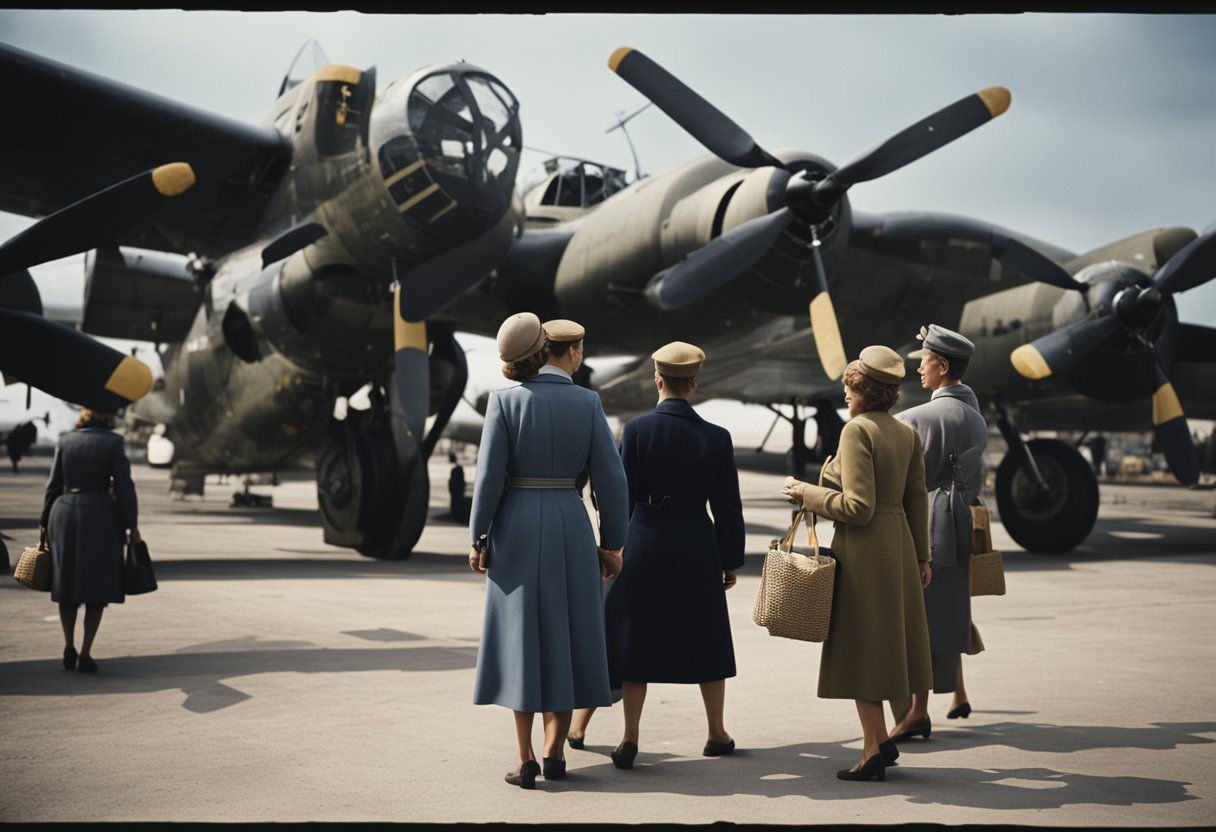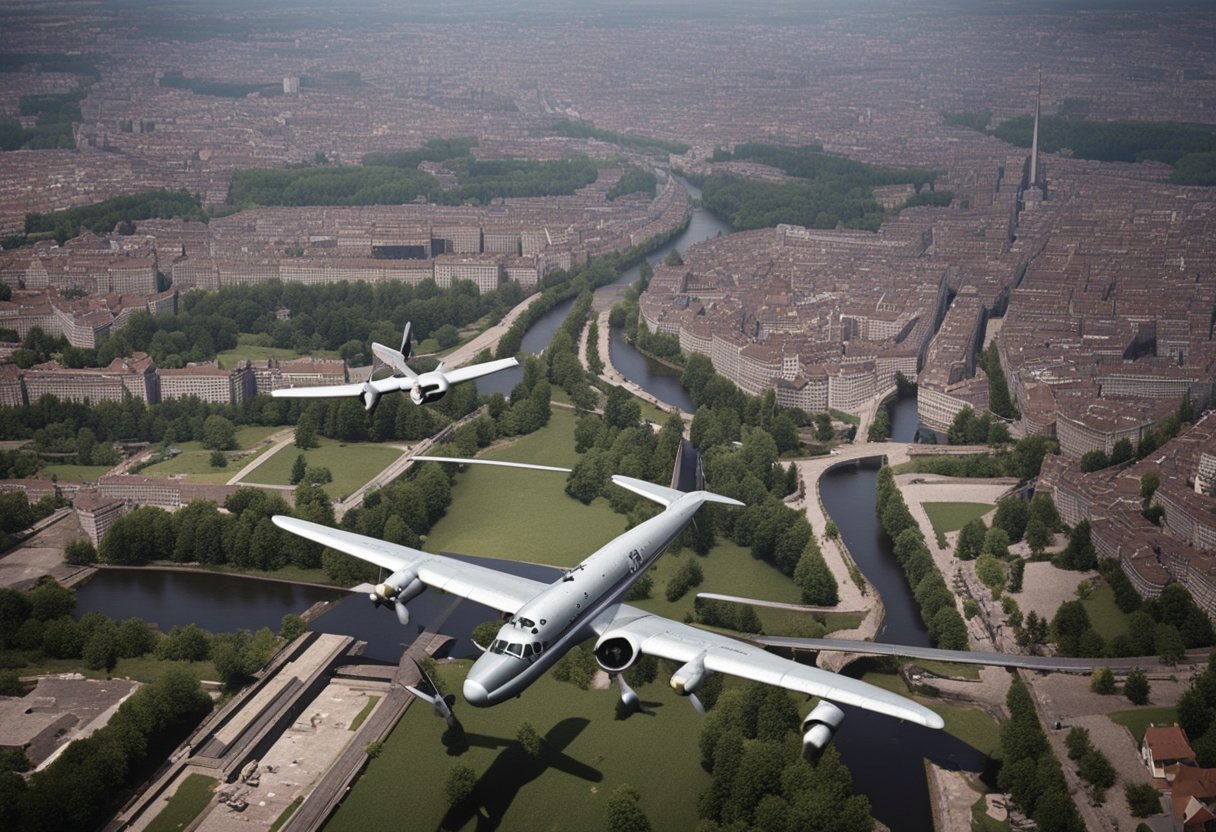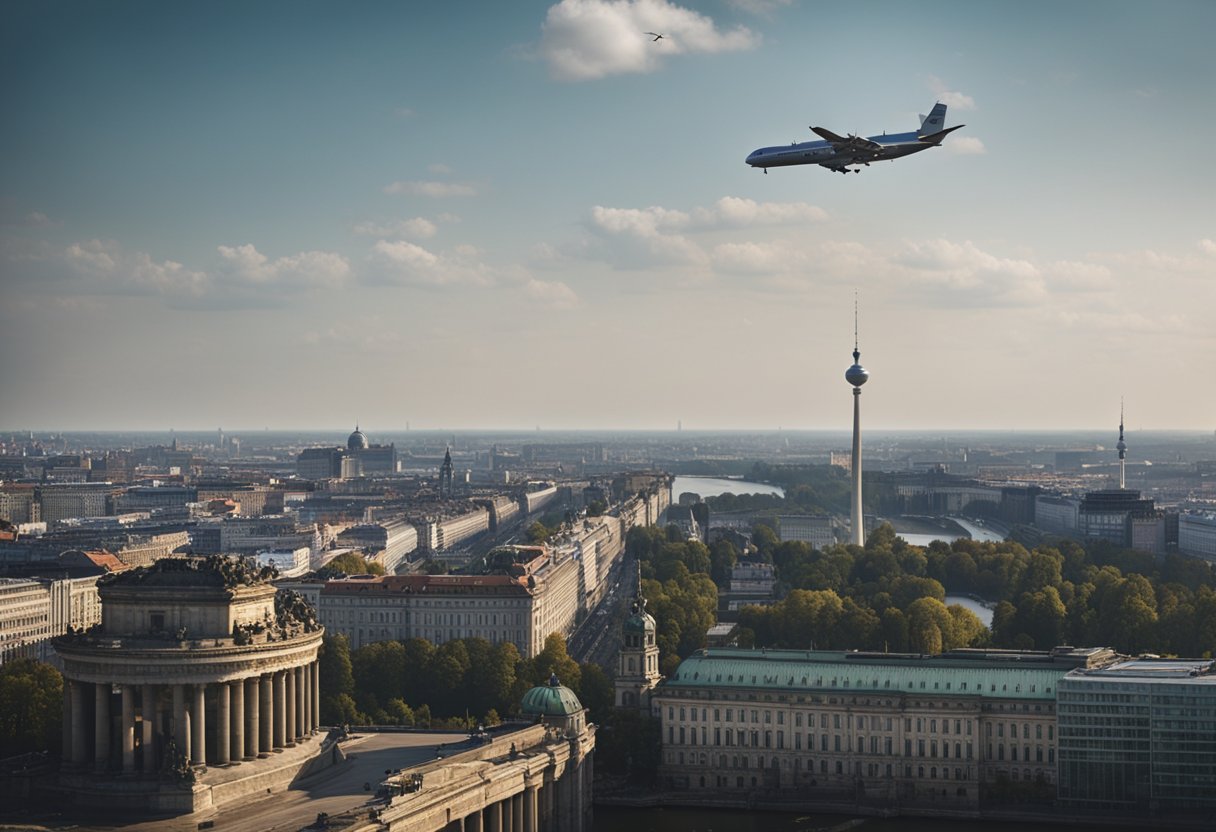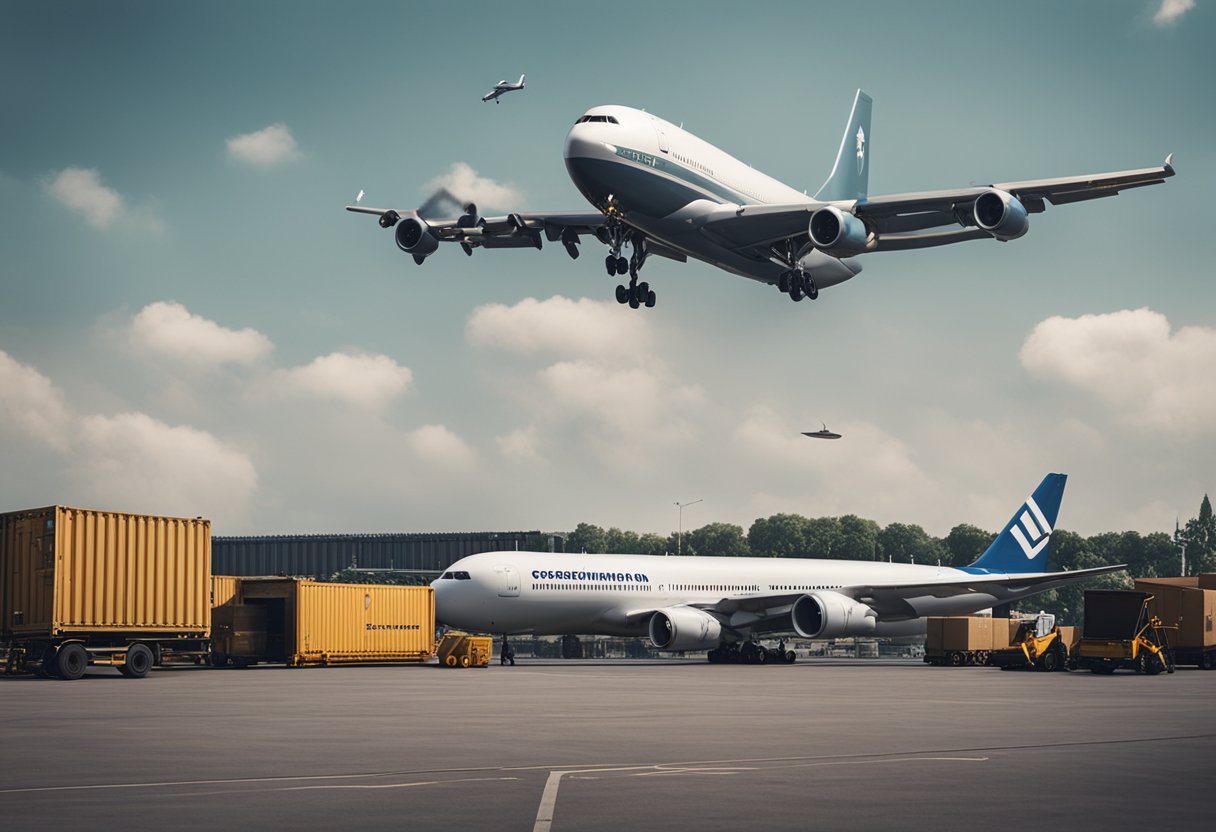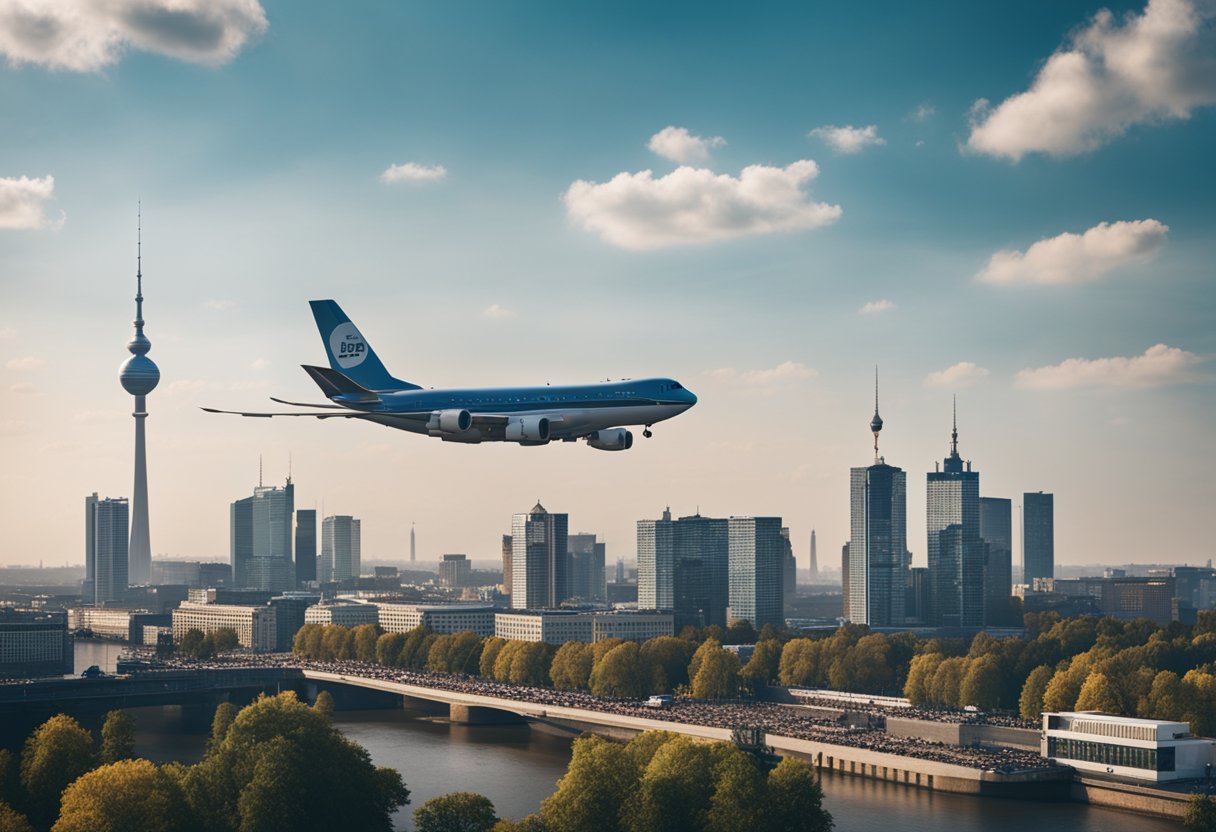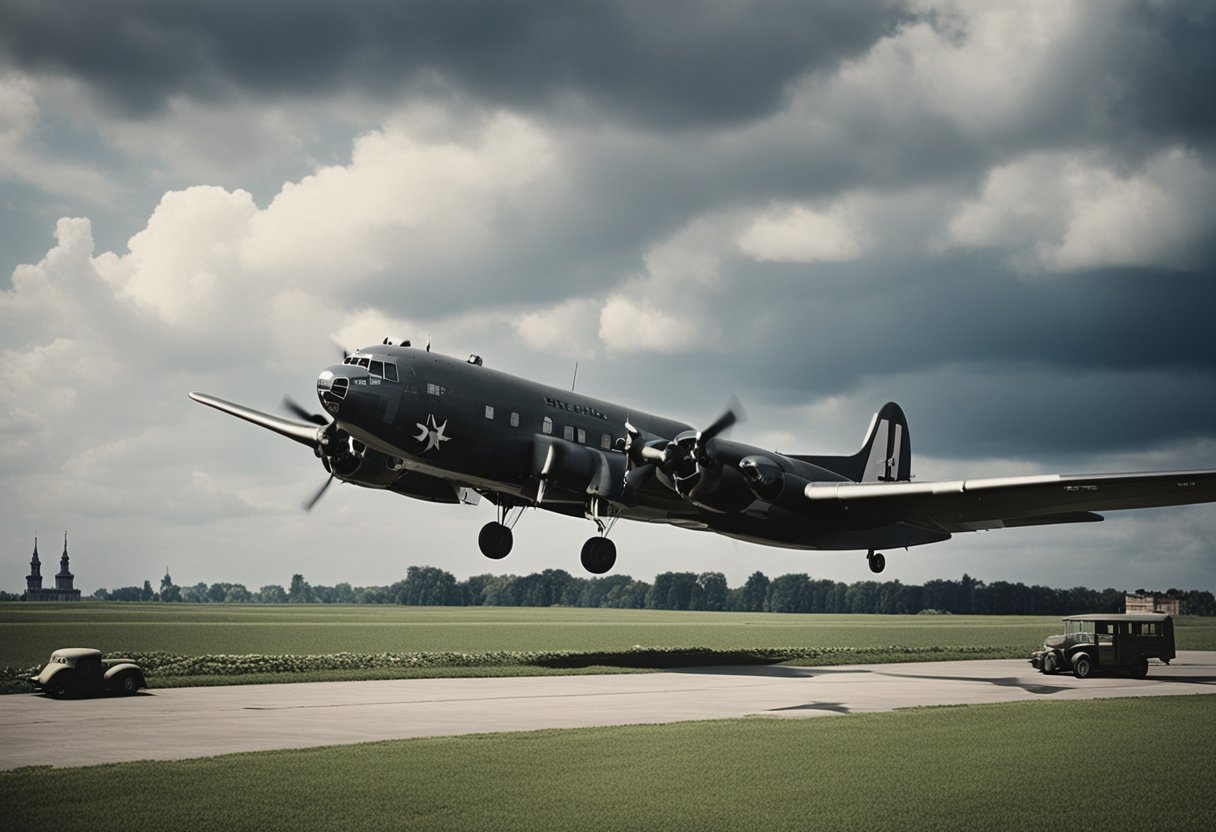The Berlin Airlift stands as a monumental event in the history of Germany and a crucial episode in the unfolding narrative of the Cold War.
In 1948, in response to the Soviet blockade of land routes into West Berlin, the western Allies launched a massive relief operation, delivering food, fuel, and supplies by air to the beleaguered city.
This operation, which persisted until 1949, was masterminded by General Lucius D. Clay, the military governor of the American zone in Germany, and it manifested as a non-violent but resolute reply to the Soviet challenge, reinforcing the Allies’ commitment to the freedom of West Berlin’s citizens.
The impacts of the Berlin Airlift on Germany were profound and multifaceted. Economically and logistically, the operation underlined the capability of the western Allies to sustain the city under siege conditions.
Politically, the airlift was a victory for the western bloc, showcasing the determination and resourcefulness of the Allied forces in the face of Soviet pressure.
This pivotal moment fortified the morale of West Berliners, while simultaneously signaling to both the Soviet Union and the world at large that the United States and its allies had the resolve to protect their interests in Europe.
Beyond the immediate relief it provided, the success of the Berlin Airlift had far-reaching consequences for Germany’s future. It cemented the division of East and West Berlin, paving the way for the eventual rise of the Berlin Wall.
The operation’s success also galvanized support for the political restructuring of West Germany, which eventually led to the formation of the Federal Republic of Germany.
The immense logistical accomplishments alongside the strong political gesture played a significant role in the later integration of West Germany into the NATO alliance, illustrating how an act of humanitarian aid can also wield extensive influence on international relations.
Historical Context
In the aftermath of World War II, Germany was a nation in tatters, its future uncertain. The Berlin Airlift emerged as a defining moment for the country, marking the shift from conflict to a stark ideological standoff that would shape its destiny for decades to come.
Post-World War II Germany
Following the surrender of Nazi Germany, the Allies (the American, British, French, and Soviet military forces) divided the nation into four occupation zones.
Each power controlled a section as part of the post-war recovery process. In the American sector, General Lucius D. Clay acted as the military governor, overseeing not just reconstruction efforts but also the pivotal Berlin Airlift.
This division meant that Germany didn’t just experience a physical split, but also an ideological one, setting the stage for the emergence of two distinct states: East Germany and Western Germany.
Berlin’s Strategic Importance
Berlin, sitting deep within the Soviet sector, bore an outsized significance. Despite being entirely surrounded by Soviet-controlled territory, the city itself was similarly split into four sectors, mirroring the division of Germany at large.
This unique configuration made West Berlin a symbolic and strategic outpost of the Western Allies, representing a bastion of democracy amidst a sea of communist influence.
Rising Tensions and the Division of Berlin
Tensions escalated dramatically with the imposition of the Berlin Blockade by Stalin and the Soviet Union in 1948, an attempt to squeeze the Western Allies out of the city.
In response, the Allies launched the Berlin Airlift, a massive operation that supplied West Berlin with vital goods via air. The airlift’s success defied Soviet expectations and ensured the survival of West Berlin as a free enclave.
This demonstration of resolve solidified the city’s status as a frontline in the Cold War, a clear indicator of the Allies’ willingness to confront communist aggression.
The blockade’s eventual lifting in 1949 signified a turning point and underscored the Berlin Airlift’s significance not only for Germany but for the vigour of Western commitment to post-war recovery and freedom.
The Blockade of June 24, 1948
On June 24, 1948, a significant turning point was reached in post-war Germany when the Soviet Union initiated the Berlin Blockade, cutting off all land and water routes into West Berlin and prompting the Western Allies to organize the Berlin Airlift.
Soviet Motivations
The Soviet Union’s primary aim in enacting the blockade was to assert control over the entire city of Berlin, pushing the Western Allied powers out.
The Allies had introduced a new currency in their zones, which the Soviets perceived as a threat to their influence in Germany and a violation of post-war agreements.
The blockade served as a direct challenge to Western policies and marked an escalation in the Cold War.
Implementation of the Blockade
On the day of the blockade, the Soviets blocked all railways, roads, and canals to Berlin’s Allied-controlled sectors.
This action effectively isolated West Berlin’s two million residents, cutting off their access to essential supplies such as food, electricity, and other vital resources which were primarily transported by land routes.
Impact on Berlin Residents
The immediate consequence of the blockade on Berlin residents was dire. A city still recovering from the ravages of war now faced a severe shortage of food and energy.
The lack of necessary supplies raised fears among Berliners of starvation and freezing during the upcoming winter.
The blockade became a matter of survival for West Berlin’s population and a humanitarian crisis that spurred the allied response, famously known as the Berlin Airlift.
The American general and military governor of the US zone in Germany at the time, Lucius D. Clay, played a key role in initiating the airlift operation that would become a massive logistical effort, ultimately considered a success, and was instrumental in the future shaping of Germany.
The Berlin Airlift would not only break the blockade but also become a symbol of resistance against communist aggression and a defining moment in the solidarity of the Western Allies, setting the stage for Germany’s path during the Cold War era.
Operation Vittles and Airlift Logistics
In an extraordinary feat of planning and coordination, Operation Vittles ensured the delivery of vital supplies to Berlin during the Soviet blockade. This operation highlighted the capabilities and determination of the American and British forces in the face of geopolitical adversities.
Planning the Airlift
The planning of the Berlin Airlift demanded rapid response and meticulous precision. General Lucius D. Clay, the military governor of the U.S. zone in Germany, played a central role in initiating Operation Vittles.
Clay and his team recognized the dire need to sustain the isolated Berlin population and scrambled to create a logistics framework that could operate ceaselessly under rigorous conditions.
American and British Roles
Both the U.S. and Great Britain demonstrated their logistical prowess through Operation Vittles. The American C-47s and later C-54s became workhorses of the air corridors, while the British complemented these efforts with their own fleets, showcasing unity and resilience.
Personnel from both countries worked tirelessly, showcasing not only military cooperation but also a humanitarian commitment.
Role of Tempelhof and Other Airfields
Key to the operation were the airfields, particularly Tempelhof, Gatow, and Tegel, which were rapidly expanded to accommodate the increase in traffic.
Tempelhof, located within the city, became the main hub of activity and symbolized the Airlift’s success.
The airfields operated around-the-clock, handling landings and takeoffs at intervals as short as 90 seconds, ensuring that the beleaguered city received everything from food to coal.
The Cold War and International Relations
The Berlin Airlift symbolized the escalating Cold War tensions and marked a pivotal moment in the evolution of international relations.
This operation not only highlighted the ideological divide between the East and West but also set the stage for the formation of a more organized Western alliance.
Allied Response to the Soviet Challenge
When the Soviet Union imposed a blockade on Berlin, it challenged the Western Allies’ resolve to support their sectors of the city.
In response, General Lucius D. Clay, the military governor of the US zone in Germany, orchestrated an unprecedented airlift operation.
This move by the United States, alongside France and Great Britain, supplied necessary sustenance and supplies to West Berliners, underlining the West’s commitment to resist Soviet pressure and to sustain the city amid Cold War hostilities.
NATO’s Involvement
The situation in Berlin accelerated the Western nations’ efforts to secure their collective defense, leading to the creation of the North Atlantic Treaty Organization (NATO).
The Berlin Airlift served as a demonstrative incident of the Soviet threat, which justified NATO’s principle of collective defense — an attack against one ally would be considered an attack against all.
Media Coverage and Public Perception
The media played an essential role in shaping both the domestic and international perception of the Berlin Airlift.
Reports of aircrafts landing every few minutes with vital supplies garnered global attention, casting the Western Allies, particularly the United States, as protectors of freedom and democracy during the Cold War.
This positive portrayal was significant in bolstering public support for the Western Allies’ efforts and solidifying their moral high ground in the public eye.
Economic and Humanitarian Efforts
In the wake of World War II, Germany faced dire economic challenges that were met with significant international aid efforts, notably through the Berlin Airlift and related programs which supplied essential goods and implemented crucial economic reforms.
Supplying Essential Goods
During the Berlin Airlift, which lasted from June 24, 1948, to May 12, 1949, a vast array of food, fuel, coal, and medicine was transported into West Berlin.
This operation was vital in sustaining over 2 million Berliners when land and water access had been blocked by the Soviet Union.
It stands as a monumental endeavor, with American and British aircraft collectively executing over 277,000 flights, delivering an estimated 2.3 million tons of supplies.
The airlift not only exemplified an extraordinary humanitarian effort but also represented a firm commitment to the citizens of West Berlin, ensuring they did not succumb to the desperation of shortages or Soviet pressure.
Currency Reform and the Marshall Plan
In 1948, currency reform in West Germany introduced the Deutschmark to replace the Reichsmark, stabilizing the German economy and laying the groundwork for future prosperity.
This transition was a prerequisite for the Marshall Plan, an American initiative that provided over $12 billion in economic assistance to Western European countries.
The Marshall Plan facilitated the resurgence of West Germany’s industry and infrastructure, boosting the economy and re-integrating the region into the European community.
This endeavor was overseen by General Lucius D. Clay, the military governor of the US zone, who is often credited with the success of the Berlin Airlift and for advocating the economic policies that helped in reviving Germany’s economy post-war.
These economic interventions were critical in shaping the future of Germany, ensuring a quicker recovery, alleviating the immediate suffering of its people, and setting a precedent for how democratic nations could come together to support one another in times of crises.
End of the Blockade and Aftermath
The culmination of the Berlin Airlift on May 12, 1949, marked a turning point for post-war Germany, leading to lasting changes in the political landscape of both East and West Germany and setting the stage for the Cold War.
Soviets Lift the Blockade
On May 12, 1949, the Soviet Union lifted the blockade of Berlin, an action that had severed supply lines to West Berlin for nearly a year.
This decision came after a successful Allied effort, known as the Berlin Airlift, which air-dropped vital supplies into the city to sustain its residents.
The US military governor and general, Lucius D. Clay, played a crucial role in orchestrating the airlift operations. His leadership helped maintain access to the city and demonstrated the resolve of Western powers to counter Soviet pressure.
Creation of the Federal Republic of Germany
Following the blockade, there was a clear division between East and West Germany. The Federal Republic of Germany (West Germany) was officially established on May 23, 1949.
This new German state represented the areas managed by the American, British, and French forces and became a pivotal member of the Western Bloc during the Cold War.
Long-Term Outcomes for East and West Berlin
The end of the blockade did not ease the tension between the Soviet-controlled and Western-aligned sectors.
Instead, it entrenched the division, culminating in the construction of the Berlin Wall in 1961, which would become the physical symbol of the Iron Curtain. The Berlin Airlift’s success fortified the Western allies’ commitment to West Berlin, an enclave of freedom within communist East Germany.
This episode significantly influenced the Cold War’s future, as it highlighted the determination of Western powers to oppose Soviet expansionism, setting a precedent for future standoffs between East and West.
The Legacy of the Berlin Airlift
The Berlin Airlift remains a monumental event, symbolizing the determination of democratic nations to withstand the pressures of communism and preserve the freedom of Berlin’s inhabitants.
Historical Significance
The Berlin Airlift of 1948-1949 emerged as a decisive moment in the Cold War, reflecting the West’s ability to mobilize resources in response to the Soviet blockade.
This operation not only saved West Berlin from communist control but also set a precedent for how the West would counter similar Soviet actions in the future.
Impact on German-American Relations
Under the leadership of General Lucius D. Clay, the Berlin Airlift strengthened German-American connections, as the United States played a crucial role in demonstrating their commitment to Germany’s democracy and well-being.
This helped lay the foundation for a lasting alliance that eventually led to Germany’s membership in NATO.
Remembrance and Commemoration
In Germany, numerous commemorations pay homage to the life-sustaining efforts of the Airlift.
From museums to memorials, these sites ensure that the memory of the Airlift and its importance in sustaining Berlin’s freedom during a time of intense geopolitical tension remains vivid within public consciousness.
The Airlift is often referred to as a successful demonstration of American resolve and a symbol of the non-violent strategies employed during the Cold War.
Frequently Asked Questions
The Berlin Airlift marked a pivotal moment in post-World War II history, shaping geopolitical relationships and military strategy during the early years of the Cold War.
Why was the Berlin Airlift initiated?
The Berlin Airlift was initiated in response to the Soviet blockade of Berlin in June 1948. The blockade was an attempt to force the Western Allies out of the city by cutting off all ground transport routes to West Berlin.
How did the Berlin Airlift influence the outcome of the Cold War?
The successful completion of the Berlin Airlift demonstrated the Western Allies’ commitment to resisting Soviet pressure and maintaining their presence in Berlin. This event laid the groundwork for NATO’s formation and the West’s resolve to contain communism.
What consequences did the Berlin Airlift have for the relationship between East and West Germany?
The Berlin Airlift intensified the division between East and West Germany. It solidified the ideological divide and was a precursor to the construction of the Berlin Wall, further cementing the separation of the two states.
In what ways did the Berlin Airlift affect the perception of the United States in Europe?
The Berlin Airlift boosted European confidence in the United States’ commitment to protect democratic nations against Communist expansion. It showcased the adaptability and resourcefulness of the U.S. military under the leadership of General Lucius D. Clay.
What were the logistical challenges and outcomes of the Berlin Airlift operation?
The operation faced significant logistical challenges, including maintaining a continuous flow of supplies and navigating difficult weather conditions. Despite these challenges, the airlift successfully supplied West Berlin with vital necessities for nearly a year.
What long-term effects did the Berlin Airlift have on the global fight against communism?
The Berlin Airlift had long-term effects on the global fight against communism by setting a precedent for a strong Western response to Soviet aggression. It also showcased the Western Allies’ capability to organize and execute a large-scale humanitarian mission in the face of opposition.
